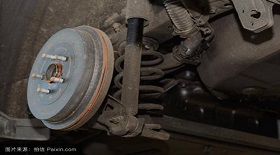Drum brake
Drum brake is also called block braking, which is realized by pressing the brake block on the brake wheel. Drum brake is an early designed brake system. The design of drum brake has been used in carriage since 1902. It was not widely used in automobile industry until about 1920. The main stream of drum brake is tensioned brake. Its brake block (brake shoe) is located inside the brake wheel. When braking, the brake block opens outward and rubs the inside of the brake wheel to achieve the purpose of braking. Compared with disc brake, drum brake has much worse heat dissipation and poor stability of braking force. Braking force varies greatly on different roads and is difficult to control. Due to the poor heat dissipation, a lot of heat will be gathered during the braking process. Brake blocks and drums are prone to complex deformation under the influence of high temperature, which can easily cause braking deterioration and chattering and decrease braking efficiency. In addition, after using drum brake for a period of time, the gap of brake shoes should be regularly adjusted, and even the whole drum should be removed to clean up the accumulated brake powder. Of course, drum brake is not useless, it is cheap, braking power, and in line with the traditional design. In the braking process of four-wheeled car, because of inertia, the front wheel usually accounts for 70-80% of the total load of the car. The braking force of the front wheel is larger than that of the rear wheel. The rear wheel plays an auxiliary braking role. Therefore, in order to save cost, car manufacturers adopt the braking mode of front disk and rear drum. However, for heavy-duty vehicles, because the speed is generally not very high, the durability of brake shoes is higher than that of disc brakes, and the braking force is large, so many heavy-duty vehicles still use four-wheel drum design.
I am looking forward to visiting Mechanical parts Exhibition.



